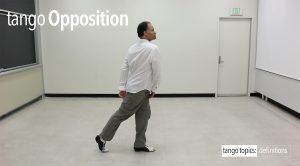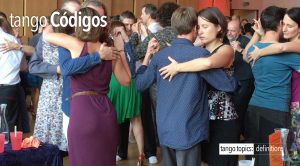The Definitions of Tango

Definition: 7 Basic Moves
7 Basic Moves. There are seven basic moves to Argentine Tango from which the dance is derived. In order, and sequence, they are 1.) Forward Steps. 2.) Side Steps. 3.) Back Steps. 4.) Forward/Back Ochos (all 8 varieties included). 5.) Follower’s Giro/Lead Giro (all 8 varieties included)….

Definition: Opposition
Usage. In the case of Argentine Tango, the concept and activity of Opposition does not come anywhere close to it’s dictionary counterpart. And that’s because it’s derivative of the completed phrase, “Walking-In-Opposition”.

Definition: Salida
Usage. Argentine Tango defines this word to mean a host of practices that can and do happen at the beginning and sometimes the ending of a song and tanda. Historically the word is defined, again from a Tango perspective, to mean a specific step that is done to indicate that we are dancing now.

Definition: Mordida
Usage. In the case of Argentine Tango, we use, and define, the word Mordida in a very specific way. We mean to define what one dancer can do to another dancer’s feet, to ‘sandwich’ one feet between two others. Typically this is done to the Follower by the lead in one of 4 pieces of Tango vocabulary: Volcada, Colgada, Parada, or Barrida. However, a good portion of Leads, employ this idea every time they come to a stop, which is an error.

Definition: Códigos
the word Códigos in a very specific manner. We mean it as an all encompassing umbrella term for a set of actions that create the social context of how we engage and comport ourselves at, and within, the Milonga experience. Códigos can be, but is not limited to: How we enter a room, Who we talk to (or don’t), Where we sit and who we sit with,

Definition: Connection
Usage. In the case of Tango Connection we use this word in a very different way than as intended of its 5 possible definitions. We use it in 1 of 6 common ways (listed here) of the 8 possible meanings that it has been used over the years. 1.) It is meant as a way to talk about a way or method of communication between the dancers….

Definition: Applied Disassociation
However, we want to release that torsion at a time and place of our choosing. That release is the a completion of sorts, the lower half of the body (hips, thighs, knees, ankles, and feet) catches up to the upper half.

Definition: Disassociation
Usage. Disassociation from a Tango Perspective isn’t that far from it’s dictionary cognate, because there is a break from the whole, as in the whole body. Typically when we talk about Tango Disassociation we are referring to the top half of the body (head, torso, arms, shoulders) rotating to the left or to the right, as one unit, around the spinal column of the dancer, independently of the lower half of the body (hips, thighs, knees, ankles, and feet).

Definition: Pivot
Usage. A Pivot from a Tango Perspective is very similar to its literal dictionary cognate with a minor difference. The difference in this case is where that turn or oscillation happens. Typically when we’re talking about a Tango Pivot, we’re referring to the entire body rotating over a singular axial point.

Definition: Pronate/Supinate
Usage. In the case of Pronation it is a telltale sign that the dancer (lead or follow) has an unconscious lack of control and precision in their motions between the steps (sometimes referred to as a ‘dangling’ foot) which also speaks to their lack of detailed work that must occur at all points along a step and movement.

Definition: Resistance
Tango Resistance or Resistance in Tango refers to the using the arms, hand, forearm, bicep, and scapula to create a state of matching tensile strength from the Follower’s Right arm, and the Lead’s Left arm of the Embrace. This is done from Open, Close, Closed, ‘V’, Open-V, Closed-V, the Berlin Embrace, or any of the standard embrace formats.

Definition: Pulling
Tango Pulling or Pulling in Tango occurs when we use both our arms as either a Lead or a Follow. In the case of the Lead, they may pull with their Left arm and hand, and/or at the same time with their Right hand, forearm, bicep. The Follower usually only pulls with their Right hand and arm.
